Dr Vino's wine blog
wine talk that goes down easy
Proof is not in the bottle: Maker’s Mark waters down
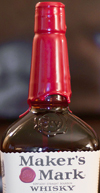 Maker’s Mark has high demand, says Beam Inc., the bourbon brand’s owner. So high, that they will be lowering the alcohol in the bottle from 45% to 42%, or 84 proof.
Maker’s Mark has high demand, says Beam Inc., the bourbon brand’s owner. So high, that they will be lowering the alcohol in the bottle from 45% to 42%, or 84 proof.
Hey, wait–I thought the consumer was the one who was supposed to add the (soda) water! This is clearly some sort of spin on cost-cutting (the tax from the distiller to the TTB comes down with the proof, too). Because, ya know, if it ain’t broke… Read more…
All quotes edition – Tasting sized pours
How great it is
“2005 was my best vintage–until 2006.” Franz Pichler of FX Pichler in Austria told me at a tasting.
Why drink wine?
“Twenty five years ago people drank wine for three reasons: 1) allegedly because it made dinner better; 2) because it made the people at dinner better; and 3) to intimidate others. Now, the first two reasons are still valid but the third is to ensure you will have sex within six hours of drinking the wine.” –Josh Wesson, founder of Best Cellars, at a Vinexpo panel about “millennials” in New York yesterday.
All for one?
“It is a reasonably well-known fact that the largest buyer of classified growth Bordeaux…..with a heavy emphasis on FIRST GROWTHS, is the Asian chairman of a major…and I mean major company….of course all his activity is done through third/fourth/fifth party strawmen….and not one auction house or wine merchant would dare reveal the name(and they all know who it is)….purchases to the tune of 40-50 million dollars per year for about 4-5 years.” [Robert Parker, on his BB, ellipses in original]
Vodka, aka, diluted ethyl alcohol
“The European Union would define vodka simply as diluted ethyl alcohol, which is, of course, what it is. That suits members like Britain, the Netherlands, France and Austria, which wring “vodka†from anything from grape mush to sugar cane. The quotes are important here, because countries of the Vodka Belt around the Baltic Sea, which have distilled the stuff for centuries and produce two-thirds of the European Union’s vodka, insist their traditional use of grains and potatoes to make vodka should be enshrined in the definition. All else, they insist, is mere regional swill, and should be labeled as such.” [Serge Schmemann in the NYTimes]
Truth in labeling
“It might be disenchanting if the label also listed the chicken, fish, milk and wheat products that are often used to process wine.” Oh those? Not so much. But what’s this Mega Purple? [LA Times]
Blind tasting the hooch: brown bagging three dark spirits
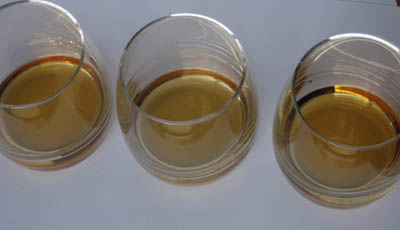
Do you know your spirits? Try tasting them blind. Brown bag optional.
Taking a page from the blind wine tasting, we’ve been subjecting dinner guests to blind spirits tastings recently.
I pour three dark spirits of similar age into three glasses. Telling them apart by color is nearly impossible. The aromas tip off a lot of people. And on the palate is usually a dead give away.
It’s a fun way to sharpen your understanding of what cognac, whisky, and aged rum taste like. Here are the three that I’ve been pouring:
Chateau Fontpinot (Frapin), XO cognac (about $90; find this cognac) *
Bowmore, Islay, 18 year old whisky (about $80; find this whisky) *
Rhum Barbancourt, Haiti, 15 year old (about $35; find this rum) **
* These spirits were samples
** This spirit was purchased at duty free
A warming whisky on a wintry day
On a frigid day last week, I traversed the frozen tundra bundled in a coat, scarf, hat and gloves to attend a tasting. It wasn’t the ordinary type of tasting I attend: a man with a kilt greeted me. I didn’t ask him if he was, um, wearing the proper insulation given the fact that it was 20 degrees below freezing. But since he was a Scot and his bare knees were visible, I doubt it. [shudder]
The tundra was actually mid-town Manhattan and, fortunately for me, the tasting was of warming single malt whisky. The producer Bowmore is introducing some new packaging, new single malts and extended an invitation to me. Even though my bailiwick is wine, I figured it was worth a shot to check it out in the name of exploration. After all, I just went to cognac so why not explore another of the oak-aged spirits?
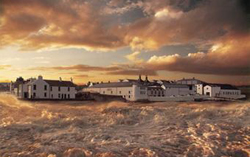 Bowmore, fully-owned by Suntory since 1994, is a top 10 whisky brand and has experienced 222 percent growth in recent years compared to a five percent growth for whisky overall. Despite this torrid growth, management is preparing a 20 million pound advertising campaign in the next few years.
Bowmore, fully-owned by Suntory since 1994, is a top 10 whisky brand and has experienced 222 percent growth in recent years compared to a five percent growth for whisky overall. Despite this torrid growth, management is preparing a 20 million pound advertising campaign in the next few years.
I sat through a powerpoint slide show of of the island of Islay, the distillery, and the labels to David Bowie’s “Changes.” On the topic of the island, I always love to improve my English so I was pleased to learn how to pronounce it correctly: eye-luh, not iss-lay the way I had said in numerous duty-free stores. The floor-malted barley will stay but the distillery and surrounding buildings have undergone some changes. Some cottages available for tourists while locals and tourists alike can enjoy a new swimming pool heated with excess heat from the distillery.
On the labels and packaging, not exactly a riveting topic for consumers, the arching Bowmore has been retained, the label is less cluttered, and they have substituted copper for gold to be more reminiscent of the stills.
There’s also a noticeable shift in the style. Wine lovers might be amused that whisky producers rejoice in using other people’s old barrels. A favorite has been the previously used bourbon barrel. But the trend now seems to be finishing the aging in old sherry barrels of 500 liters. This type of barrel adds greater aromatic intensity and shifts the aromas from the briney, peaty overtones to sweeter, more complex notes of dried fruits. More cognac-like, in fact, now that I have experience with ‘yak. Why are they doing this? In part, one representative said, it’s the Americans who like it sweet.
That reminded me not only of Yellow Tail and its 30 grams of residual sugar but of a great quote I read in the NYT last week. “When I go back to the U.S.A. everything seems sweet,†Brian Silva, an American who has tended bar in London for 25 years said. “Flavored vodkas, flowers and bits and pieces — pinkie-raising drinks. No. All my cocktails are made with alcohol.â€
This stylistic shift also makes Bowmore more Macallan-like. Similarly, Bowmore is also retiring their 17 year old and replacing it with what is now the more standard 18 year old complete with extended sherry barrel aging.
Turning to the whiskys themselves, the introductory Legend (find this whisky) with eight years aging is easy drinking and a good value for $25. The Bowmore people even said it was OK serve this one on the rocks. But all I could think about mid-winter was a hot toddy.
The 12 year old (about $45; find this whisky) has more depth and almost honeyed richness to accompany the signature smokiness and peat notes. A peppery burn kicks in on the warming finish.
The “Darkest” 15 year old is indeed dark as we enter into the sherry cask zone with three years in sherry casks. More smokiness, but mellow under a toffeed richness. (find the Darkest)
The 18 year old, brand new to the market, was the most alluring thus far exhibiting wonderful peaty, smoky richness complemented with aromas of dried sultanas, toffee, and a subtle chocolatey-ness. Hugely warming and smooth finish. Darker in color, this blend saw 50-50 bouron-sherry casks. Despite the $85 price tag, this is probably the one I would buy since I drink whisky at the rate of one bottle per decade. Might as well make it good. (find this whisky)
The bad news is that not all the whiskys are available right now but will be arriving in the coming weeks. The producer splits the product line into a “core range” available in shops and a “duty free range” that is only available where the name implies. At the request of the influential duty free shops, the bottle sizes and ages available at duty free shops are different form the stores to prevent easy price comparisons. Those crafty duty free people…But I preferred the “core range” anyway.
Check for the latest at the Bowmore web site.
 tags: whisky
tags: whisky
Judge this cognac by its bottle
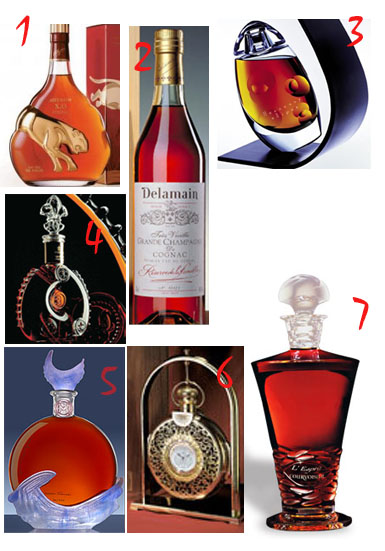 Cognac bottles come in all shapes and sizes. In fact the relatively new Cognac Museum has a whole room dedicated to their historical evolution. Some look like wine bottles while others look more like perfume bottles.
Cognac bottles come in all shapes and sizes. In fact the relatively new Cognac Museum has a whole room dedicated to their historical evolution. Some look like wine bottles while others look more like perfume bottles.
In this assortment of bottles, which one do you think is the most expensive? And the least expensive? And how about your faves? Have your say in the comments!
In a future post, I’ll tell you what’s what–and how much.
 tags: cognac | bottle design
tags: cognac | bottle design
Mummifying cognac in demi-johns
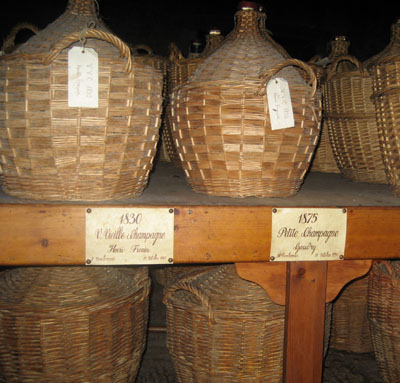
Perhaps you’ve read about–or even tried–cognacs that are over a century old. But given that it can’t last more than 55 years in the oak barrel, what’s the next step?
Demi-johns. These large glass containers, shrouded in wicker or burlap to keep out the light, protect the cognac after the transformative magic of the oak barrel. As Dominique Touteau, cellar master at Delamain, put it to me, the cognac is “mummified” in the bottle. Unlike wine, there’s no such thing as bottle aging in Cognac. It simply maintains the properties acquired from the barrel, the vintage and the growing area. Even though the cellar for the demi-johns is airless and timeless, its not really a tomb as much as it is a preservation chamber. Cryogenics, if you will. They are often stored in an inner-sanctum known as the “paradis,” translated as paradise or Heaven. The term sets the bar high, but then again, these old cognacs can be ethereal.
The demi-johns, or Dames-Jeannes as they are known in French, are stored tightly sealed, upright and out of the light. Every ten years they are given a new cork.
When the cellar master deems it the right time, small amounts of the cognac in demi-johns can be added to the finest blends. I saw one at Martell that was supposedly from 1830, which is mind-blowing to think of the history it’s seen–or not since it has been hidden in a dark cellar.
Stay tuned to find out my tasting notes from the oldest cognac I tasted on my trip! (Bonus points for anyone who can guess the vintage in advance)
The colors of Cognac
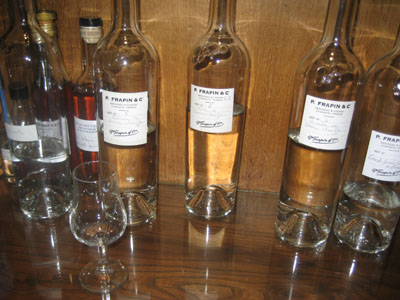
When a distilled spirit is 70 percent alcohol, can you taste the difference? In Cognac, the answer is yes. The cellar master receives the samples of the distillate and smells them for their aromatic qualities. I did it and it was, well, mostly alcohol. But then he adds water to the raw spirit, which, surprisingly to me, greatly amplifies the aromas. Suddenly there were many more aromas and it was possible to distinguish between two distillations from different vineyard sites. In the photo above, distillations from different areas are on the tasting table at Frapin.
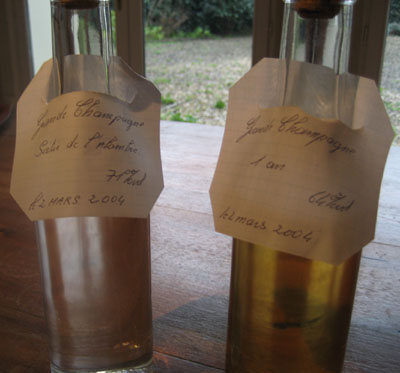
All the spirits are clear immediately after distillation–it’s only the oak aging that adds the enticing golden hue. The photo above shows the distillate fresh out of the alembic and, on the right, after one year of aging in an oak barrel.
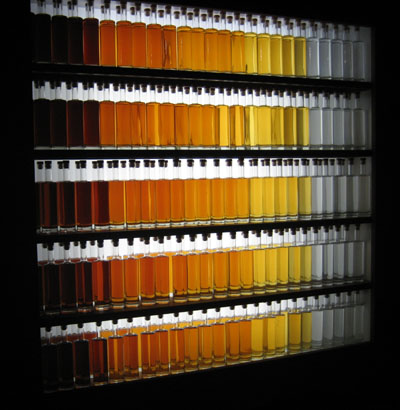
The longer in the barrel, the richer and darker the colors become. The Cognac house Camus has a beautiful demonstration of the progression on display. The just-distilled spirits are on the right moving all the way to fifty-year-old samples from oak casks the left.
 tags: cognac | barrel aging
tags: cognac | barrel aging
Barrel sample, cognac style
Domique Touteau, cellar master at Delamain, draws a sample from a 1967 barrel of Cognac. Instead of a pipette, more common in the wine world, he uses a “prouvette.” The prouvette is a glass vial tied to a string that he drops in the barrel. If you listen you can hear the bubbles as it fills up. Unfortunately the only light we had in the cellar was one light bulb. Even thought the video is dark, you can still see the golden color in the glass. And the chalk markings on the outside of the barrel indicate its origin, harvest date and the alcohol strength. No barcodes here…
 tags: cognac | barrel sample
tags: cognac | barrel sample



